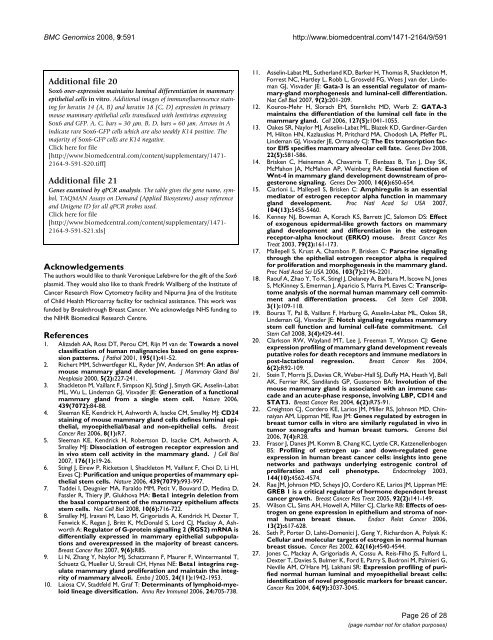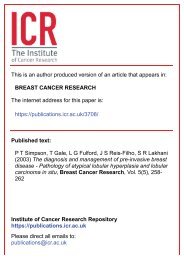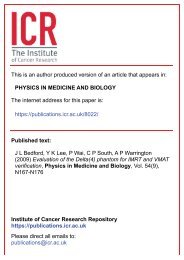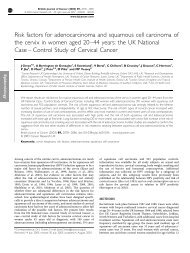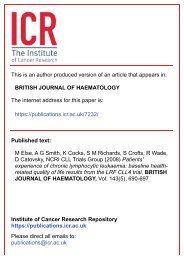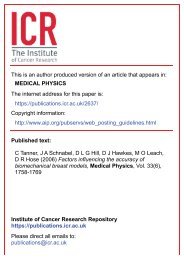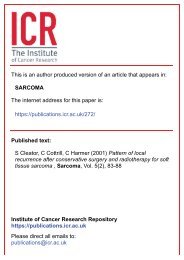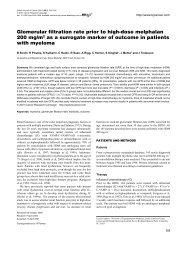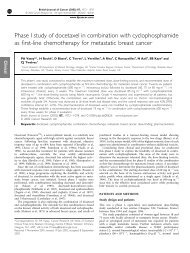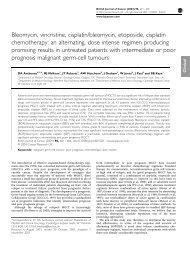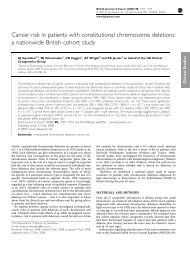Transcriptome analysis of mammary epithelial subpopulations ...
Transcriptome analysis of mammary epithelial subpopulations ...
Transcriptome analysis of mammary epithelial subpopulations ...
You also want an ePaper? Increase the reach of your titles
YUMPU automatically turns print PDFs into web optimized ePapers that Google loves.
BMC Genomics 2008, 9:591http://www.biomedcentral.com/1471-2164/9/591Additional file 20Sox6 over-expression maintains luminal differentiation in <strong>mammary</strong><strong>epithelial</strong> cells in vitro. Additional images <strong>of</strong> immun<strong>of</strong>luorescence stainingfor keratin 14 (A, B) and keratin 18 (C, D) expression in primarymouse <strong>mammary</strong> <strong>epithelial</strong> cells transduced with lentivirus expressingSox6 and GFP. A, C, bars = 30 μm. B, D, bars = 60 μm. Arrows in Aindicate rare Sox6-GFP cells which are also weakly K14 positive. Themajority <strong>of</strong> Sox6-GFP cells are K14 negative.Click here for file[http://www.biomedcentral.com/content/supplementary/1471-2164-9-591-S20.tiff]Additional file 21Genes examined by qPCR <strong>analysis</strong>. The table gives the gene name, symbol,TAQMAN Assays on Demand (Applied Biosystems) assay referenceand Unigene ID for all qPCR probes used.Click here for file[http://www.biomedcentral.com/content/supplementary/1471-2164-9-591-S21.xls]AcknowledgementsThe authors would like to thank Veronique Lefebvre for the gift <strong>of</strong> the Sox6plasmid. They would also like to thank Fredrik Wallberg <strong>of</strong> the Institute <strong>of</strong>Cancer Research Flow Cytometry facility and Nipurna Jina <strong>of</strong> the Institute<strong>of</strong> Child Health Microarray facility for technical assistance. This work wasfunded by Breakthrough Breast Cancer. We acknowledge NHS funding tothe NIHR Biomedical Research Centre.References1. Alizadeh AA, Ross DT, Perou CM, Rijn M van de: Towards a novelclassification <strong>of</strong> human malignancies based on gene expressionpatterns. J Pathol 2001, 195(1):41-52.2. Richert MM, Schwertfeger KL, Ryder JW, Anderson SM: An atlas <strong>of</strong>mouse <strong>mammary</strong> gland development. J Mammary Gland BiolNeoplasia 2000, 5(2):227-241.3. Shackleton M, Vaillant F, Simpson KJ, Stingl J, Smyth GK, Asselin-LabatML, Wu L, Lindeman GJ, Visvader JE: Generation <strong>of</strong> a functional<strong>mammary</strong> gland from a single stem cell. Nature 2006,439(7072):84-88.4. Sleeman KE, Kendrick H, Ashworth A, Isacke CM, Smalley MJ: CD24staining <strong>of</strong> mouse <strong>mammary</strong> gland cells defines luminal <strong>epithelial</strong>,myo<strong>epithelial</strong>/basal and non-<strong>epithelial</strong> cells. BreastCancer Res 2006, 8(1):R7.5. Sleeman KE, Kendrick H, Robertson D, Isacke CM, Ashworth A,Smalley MJ: Dissociation <strong>of</strong> estrogen receptor expression andin vivo stem cell activity in the <strong>mammary</strong> gland. J Cell Biol2007, 176(1):19-26.6. Stingl J, Eirew P, Ricketson I, Shackleton M, Vaillant F, Choi D, Li HI,Eaves CJ: Purification and unique properties <strong>of</strong> <strong>mammary</strong> <strong>epithelial</strong>stem cells. Nature 2006, 439(7079):993-997.7. Taddei I, Deugnier MA, Faraldo MM, Petit V, Bouvard D, Medina D,Fassler R, Thiery JP, Glukhova MA: Beta1 integrin deletion fromthe basal compartment <strong>of</strong> the <strong>mammary</strong> epithelium affectsstem cells. Nat Cell Biol 2008, 10(6):716-722.8. Smalley MJ, Iravani M, Leao M, Grigoriadis A, Kendrick H, Dexter T,Fenwick K, Regan J, Britt K, McDonald S, Lord CJ, Mackay A, AshworthA: Regulator <strong>of</strong> G-protein signalling 2 (RGS2) mRNA isdifferentially expressed in <strong>mammary</strong> <strong>epithelial</strong> <strong>subpopulations</strong>and overexpressed in the majority <strong>of</strong> breast cancers.Breast Cancer Res 2007, 9(6):R85.9. Li N, Zhang Y, Naylor MJ, Schatzmann F, Maurer F, Wintermantel T,Schuetz G, Mueller U, Streuli CH, Hynes NE: Beta1 integrins regulate<strong>mammary</strong> gland proliferation and maintain the integrity<strong>of</strong> <strong>mammary</strong> alveoli. Embo J 2005, 24(11):1942-1953.10. Laiosa CV, Stadtfeld M, Graf T: Determinants <strong>of</strong> lymphoid-myeloidlineage diversification. Annu Rev Immunol 2006, 24:705-738.11. Asselin-Labat ML, Sutherland KD, Barker H, Thomas R, Shackleton M,Forrest NC, Hartley L, Robb L, Grosveld FG, Wees J van der, LindemanGJ, Visvader JE: Gata-3 is an essential regulator <strong>of</strong> <strong>mammary</strong>-glandmorphogenesis and luminal-cell differentiation.Nat Cell Biol 2007, 9(2):201-209.12. Kouros-Mehr H, Slorach EM, Sternlicht MD, Werb Z: GATA-3maintains the differentiation <strong>of</strong> the luminal cell fate in the<strong>mammary</strong> gland. Cell 2006, 127(5):1041-1055.13. Oakes SR, Naylor MJ, Asselin-Labat ML, Blazek KD, Gardiner-GardenM, Hilton HN, Kazlauskas M, Pritchard MA, Chodosh LA, Pfeffer PL,Lindeman GJ, Visvader JE, Ormandy CJ: The Ets transcription factorElf5 specifies <strong>mammary</strong> alveolar cell fate. Genes Dev 2008,22(5):581-586.14. Brisken C, Heineman A, Chavarria T, Elenbaas B, Tan J, Dey SK,McMahon JA, McMahon AP, Weinberg RA: Essential function <strong>of</strong>Wnt-4 in <strong>mammary</strong> gland development downstream <strong>of</strong> progesteronesignaling. Genes Dev 2000, 14(6):650-654.15. Ciarloni L, Mallepell S, Brisken C: Amphiregulin is an essentialmediator <strong>of</strong> estrogen receptor alpha function in <strong>mammary</strong>gland development. Proc Natl Acad Sci USA 2007,104(13):5455-5460.16. Kenney NJ, Bowman A, Korach KS, Barrett JC, Salomon DS: Effect<strong>of</strong> exogenous epidermal-like growth factors on <strong>mammary</strong>gland development and differentiation in the estrogenreceptor-alpha knockout (ERKO) mouse. Breast Cancer ResTreat 2003, 79(2):161-173.17. Mallepell S, Krust A, Chambon P, Brisken C: Paracrine signalingthrough the <strong>epithelial</strong> estrogen receptor alpha is requiredfor proliferation and morphogenesis in the <strong>mammary</strong> gland.Proc Natl Acad Sci USA 2006, 103(7):2196-2201.18. Raouf A, Zhao Y, To K, Stingl J, Delaney A, Barbara M, Iscove N, JonesS, McKinney S, Emerman J, Aparicio S, Marra M, Eaves C: <strong>Transcriptome</strong><strong>analysis</strong> <strong>of</strong> the normal human <strong>mammary</strong> cell commitmentand differentiation process. Cell Stem Cell 2008,3(1):109-118.19. Bouras T, Pal B, Vaillant F, Harburg G, Asselin-Labat ML, Oakes SR,Lindeman GJ, Visvader JE: Notch signaling regulates <strong>mammary</strong>stem cell function and luminal cell-fate commitment. CellStem Cell 2008, 3(4):429-441.20. Clarkson RW, Wayland MT, Lee J, Freeman T, Watson CJ: Geneexpression pr<strong>of</strong>iling <strong>of</strong> <strong>mammary</strong> gland development revealsputative roles for death receptors and immune mediators inpost-lactational regression. Breast Cancer Res 2004,6(2):R92-109.21. Stein T, Morris JS, Davies CR, Weber-Hall SJ, Duffy MA, Heath VJ, BellAK, Ferrier RK, Sandilands GP, Gusterson BA: Involution <strong>of</strong> themouse <strong>mammary</strong> gland is associated with an immune cascadeand an acute-phase response, involving LBP, CD14 andSTAT3. Breast Cancer Res 2004, 6(2):R75-91.22. Creighton CJ, Cordero KE, Larios JM, Miller RS, Johnson MD, ChinnaiyanAM, Lippman ME, Rae JM: Genes regulated by estrogen inbreast tumor cells in vitro are similarly regulated in vivo intumor xenografts and human breast tumors. Genome Biol2006, 7(4):R28.23. Frasor J, Danes JM, Komm B, Chang KC, Lyttle CR, KatzenellenbogenBS: Pr<strong>of</strong>iling <strong>of</strong> estrogen up- and down-regulated geneexpression in human breast cancer cells: insights into genenetworks and pathways underlying estrogenic control <strong>of</strong>proliferation and cell phenotype. Endocrinology 2003,144(10):4562-4574.24. Rae JM, Johnson MD, Scheys JO, Cordero KE, Larios JM, Lippman ME:GREB 1 is a critical regulator <strong>of</strong> hormone dependent breastcancer growth. Breast Cancer Res Treat 2005, 92(2):141-149.25. Wilson CL, Sims AH, Howell A, Miller CJ, Clarke RB: Effects <strong>of</strong> oestrogenon gene expression in epithelium and stroma <strong>of</strong> normalhuman breast tissue. Endocr Relat Cancer 2006,13(2):617-628.26. Seth P, Porter D, Lahti-Domenici J, Geng Y, Richardson A, Polyak K:Cellular and molecular targets <strong>of</strong> estrogen in normal humanbreast tissue. Cancer Res 2002, 62(16):4540-4544.27. Jones C, Mackay A, Grigoriadis A, Cossu A, Reis-Filho JS, Fulford L,Dexter T, Davies S, Bulmer K, Ford E, Parry S, Budroni M, Palmieri G,Neville AM, O'Hare MJ, Lakhani SR: Expression pr<strong>of</strong>iling <strong>of</strong> purifiednormal human luminal and myo<strong>epithelial</strong> breast cells:identification <strong>of</strong> novel prognostic markers for breast cancer.Cancer Res 2004, 64(9):3037-3045.Page 26 <strong>of</strong> 28(page number not for citation purposes)


